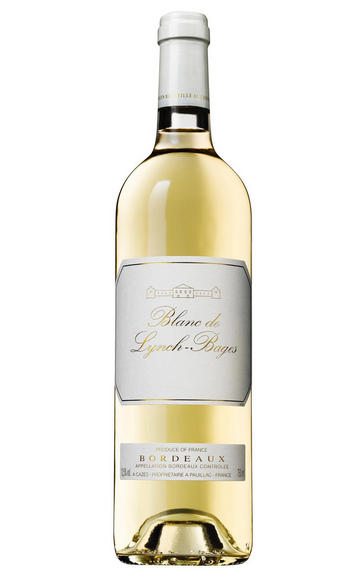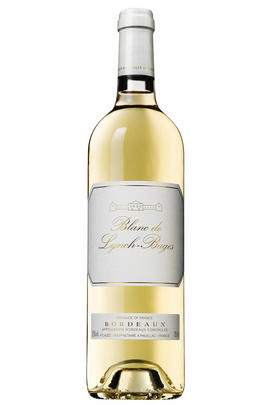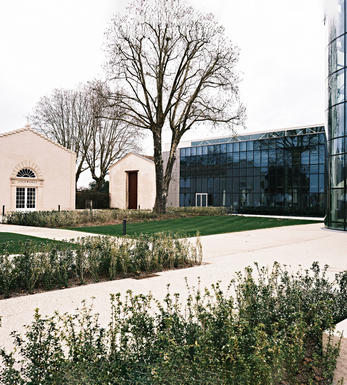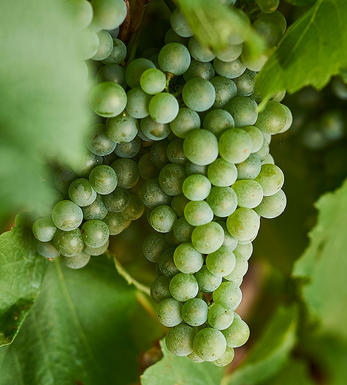
2018 Blanc de Lynch-Bages, Bordeaux

Critics reviews
This wine has a lovely complexity with balance and lift and does that thing where it waits for a heartbeat, then makes you wait for a heartbeat, before releasing its stone fruit and succulent, slate-tinged citrus.
The plots are on the west side of the appellation, often 1.5oC lower than at main Lynch Bages, with more limestone in the subsoils helping keep the balance that is evident here.
Two-thirds of the juice was fermented in barrels, with one-third in stainless steel – it’s juicy and pretty much ready to go (it bottles in two weeks). 50% new oak used. 3.08pH.
Drink 2020 - 2030
Jane Anson, Decanter.com (April 2019)
59% Sauvignon Blanc, 21% Sémillon, 20% Muscadelle. 13.1% pH 3.08. Two-thirds fermented in tank, one-third in barrel. It will be bottled in 10 days.
Complex aroma that is herbal and spicy and with a lovely nose that is so typically Bordeaux Blanc. Cedary but with lemon and grapefruit freshness too. Slight grip and moderate concentration are more interesting aromatically than for its intensity. Not very long but super-fresh.
Drink 2020 - 2024
Julia Harding MW, JancisRobinson.com (April 2019)
The 2018 Blanc de Lynch Bages shows a little reduction, opening out to notions of warm peaches, passion fruit and gooseberries and suggestions of honeysuckle, coriander seed and chalk dust. Medium-bodied, the palate is filled with tropical and citrus flavours and a racy backbone, finishing long with chalkiness.
Lisa Perrotti-Brown, Wine Advocate (April 2019)
Beautiful aromas of white peach, honeydew, white grapefruit, lemongrass, jasmine and flint. It’s full-bodied with a creamy texture and bright acidity—layered and phenolic with tangy, lightly pithy citrus notes and a mineral edge.
Drink or hold
James Suckling, JamesSuckling.com (October 2021)
Pretty pineapple, white grapefruit, and a touch of chalky minerality emerge from the 2018 Château Lynch-Bages Blanc, a fresh, lively white that has a bright spine of acidity, medium-bodied richness, and a crisp, clean finish. Drink this outstanding Bordeaux Blanc over the coming 2-4 years or so.
Drink 2021 - 2025
Jeb Dunnuck, JebDunnuck.com (March 2021)
About this WINE

Chateau Lynch-Bages
Château Lynch Bages, a 5ème Cru Classé, is one of the best-known Médoc estates and has always had a particularly strong following on this side of the English Channel. Since 1973 it has been owned by the enigmatic Jean-Michel Cazes and is now run by his son, Jean-Charles.
Lynch Bages's vineyards are superbly sited on a plateau west of Pauillac town, in the small village of Bages. The 90 hectares of vineyards (Red: Cabernet Sauvignon 75%, Merlot 15%, Cabernet Franc 10%) lie on deep gravel beds over limestone. For the reds, fermentation is temperature-controlled with extensive 'remontage' to ensure concentration and depth of colour. A special system of pipes transfers the wine from the cuves to the oak barriques (60% new) where it matures for 15 months.
Lynch Bages can be surprisingly soft and approachable when young. However, when fully mature, it develops a succulent richness and a heavenly bouquet of minty blackcurrants and cigar boxes. As Oz Clarke says "Lynch Bages is impressive at five years, beautiful at ten years and irresistible at twenty."

Pauillac
Pauillac is the aristocrat of the Médoc boasting boasting 75 percent of the region’s First Growths and with Grand Cru Classés representing 84 percent of Pauillac's production.
For a small town, surrounded by so many familiar and regal names, Pauillac imparts a slightly seedy impression. There are no grand hotels or restaurants – with the honourable exception of the establishments owned by Jean-Michel Cazes – rather a small port and yacht harbour, and a dominant petrochemical plant.
Yet outside the town, , there is arguably the greatest concentration of fabulous vineyards throughout all Bordeaux, including three of the five First Growths. Bordering St Estèphe to the north and St Julien to the south, Pauillac has fine, deep gravel soils with important iron and marl deposits, and a subtle, softly-rolling landscape, cut by a series of small streams running into the Gironde. The vineyards are located on two gravel-rich plateaux, one to the northwest of the town of Pauillac and the other to the south, with the vines reaching a greater depth than anywhere else in the Médoc.
Pauillac's first growths each have their own unique characteristics; Lafite Rothschild, tucked in the northern part of Pauillac on the St Estèphe border, produces Pauillac's most aromatically complex and subtly-flavoured wine. Mouton Rothschild's vineyards lie on a well-drained gravel ridge and - with its high percentage of Cabernet Sauvignon - can produce (in its best years) Pauillac's most decadently rich, fleshy and exotic wine.
Latour, arguably Bordeaux's most consistent First Growth, is located in southern Pauillac next to St Julien. Its soil is gravel-rich with superb drainage, and Latour's vines penetrate as far as five metres into the soil. It produces perhaps the most long-lived wines of the Médoc.
Recommended Châteaux
Ch. Lafite-Rothschild, Ch. Latour, Ch. Mouton-Rothschild, Ch. Pichon-Longueville Baron, Ch. Pichon Longueville Comtesse de Lalande, Ch. Lynch-Bages, Ch. Grand-Puy-Lacoste, Ch, Pontet-Canet, Les Forts de Latour, Ch. Haut-Batailley, Ch. Batailley, Ch. Haut-Bages Libéral.

Sauvignon Blanc & Sémillon
The blend used for White Graves and Sauternes and rarely encountered outside France. In the great dry whites of Graves, Sauvignon Blanc tends to predominate in the blend, although properties such as Smith Haut Lafite use 100% Sauvignon Blanc while others such as Laville Haut Brion have as much as 60% Sémillon in their final blends. Sauvignon Blanc wines can lose their freshness and fruit after a couple of years in bottle - if blended with Sémillon, then the latter bolsters the wine when the initial fruit from the Sauvignon fades. Ultimately Sauvignon Blanc gives the wine its aroma and raciness while Sémillon gives it backbone and longevity.
In Sauternes, Sémillon is dominant, with Sauvignon Blanc playing a supporting role - it is generally harvested about 10 days before Sémillon and the botrytis concentrates its sweetness and dampens Sauvignon Blanc`s naturally pungent aroma. It contributes acidity, zip and freshness to Sauternes and is an important component of the blend.


Buying options
Add to wishlist
Description
This wine has a lovely complexity with balance and lift and does that thing where it waits for a heartbeat, then makes you wait for a heartbeat, before releasing its stone fruit and succulent, slate-tinged citrus.
The plots are on the west side of the appellation, often 1.5oC lower than at main Lynch Bages, with more limestone in the subsoils helping keep the balance that is evident here.
Two-thirds of the juice was fermented in barrels, with one-third in stainless steel – it’s juicy and pretty much ready to go (it bottles in two weeks). 50% new oak used. 3.08pH.
Drink 2020 - 2030
Jane Anson, Decanter.com (April 2019)
wine at a glance
Delivery and quality guarantee